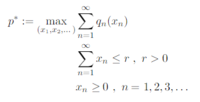Cheah Meng Yew
New member
- Joined
- Feb 16, 2020
- Messages
- 3
1) qn here represent a Function for Optimization
2) := means definition
3)p means problem
so basically it means
a problem is defined by a function q and a single variable x that starts from index n = 1 until n=infinity .
I do not know if my interpretation of it is correct and also do not get what the max means ?
2) := means definition
3)p means problem
so basically it means
a problem is defined by a function q and a single variable x that starts from index n = 1 until n=infinity .
I do not know if my interpretation of it is correct and also do not get what the max means ?

